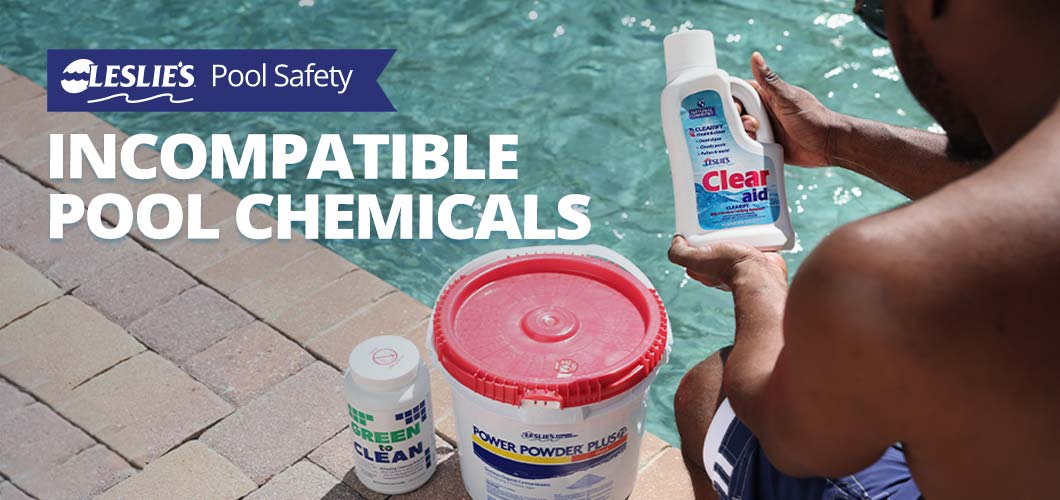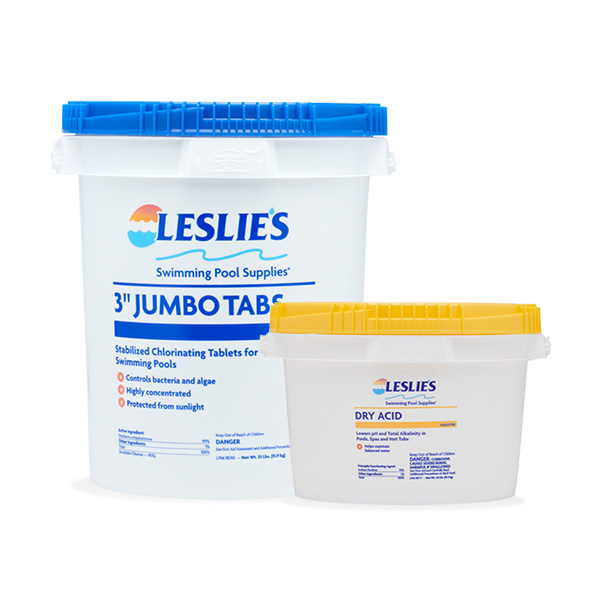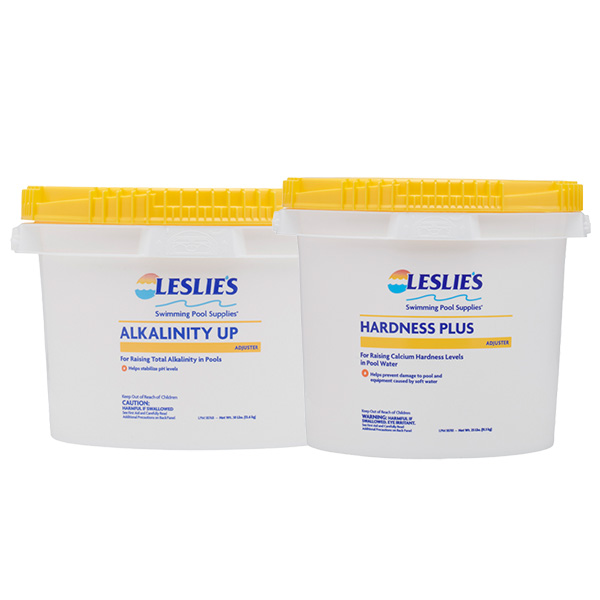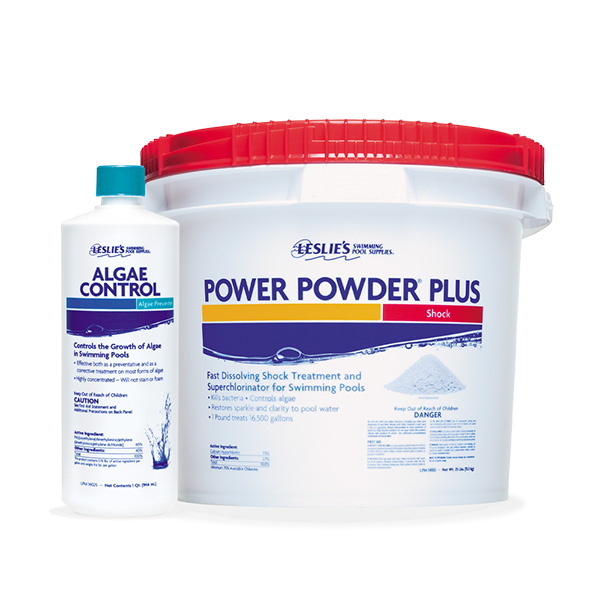
Incompatible Pool Chemicals
When adding pool chemicals to your swimming pool, it's important to avoid adding certain chemicals with others that may have negative reactions in the pool. You can avoid chemical conflicts by following instructions on each individual product to see when and how they can be introduced to the pool, as well as how long to wait before swimming or adding additional chemicals to the water. Make sure the pump is running on high speed during and between chemical additions, which will help disperse the product throughout the pool. You should also add chemicals in different areas of the pool to help prevent adverse reactions.
Below, you'll find a list of some incompatible pool chemical combinations that should never be mixed together.
PRO TIP: Always carefully read and follow all product label instructions before using any pool chemicals. The label will include warnings, safe handling, safe storage, and proper application instructions. When in doubt, we suggest waiting at least 4 hours between chemical applications as a general rule of thumb. NEVER mix any chemicals together before adding to the pool. Generally speaking, almost all pool chemicals are incompatible in some way. Safe handling and application are key!

Chlorine & Acid
Perhaps most important of all — NEVER add chlorine and muriatic acid or Dry Acid together, whether outside the pool or in it. This creates a dangerous toxic gas that can have severe health consequences if inhaled. Don't ever shock the pool immediately after adding acid to the water. Also, never add acid to the pool when chlorine levels are high, such as after you've shocked the pool. Wait at least 4 hours or more between applications.
Stabilized & Unstabilized Chlorine
NEVER mix different types of chlorine together. Mixing these incompatible pool chemicals can cause a dangerous chemical fire, explosion, or a release of toxic fumes. In fact, mixing any type of organic and inorganic chlorine compounds (that is, stabilized and unstabilized chlorine) can cause an adverse reaction. Keep your stabilized organic chlorine (dichlor shock and trichlor tablets) separate from your unstabilized inorganic chlorine (cal-hypo shock and liquid chlorine), both during pool application and while in storage.
When shocking the pool, never add your chlorine through the skimmer, especially if you have an inline or offline chlorine tablet feeder. If using a floating tablet dispenser, pour the shock far away from the dispenser, or temporarily remove it from the pool until the shock has ample time to distribute. Don't pour the shock right next to or on top of the dispenser.
Calcium Hardness Increaser & Alkalinity Increaser

Adding a hardness increaser, such as Leslie’s Hardness Plus, and sodium carbonate or sodium bicarbonate product, such as Leslie’s Soda Ash or Leslie’s Alkalinity Up, too close together is a bad idea. These two incompatible pool chemicals will react, creating calcium carbonate. This causes cloudy water and increased scaling on pool surfaces and equipment. Add Hardness Plus on a different day than Alkalinity Up or Soda Ash to avoid an issue.
Water Clarifier & Chelating or Sequestering Agents
Avoid adding a clarifier, such as Leslie’s Ultra Bright Advanced, on the same day as a chelating or sequestering agent, such as Leslie’s Stain & Scale Remove, Stain & Scale Prevent, or Leslie's NoMetal. Also, don't use a clarifier while you're in the middle of the stain removal process. Your water can cloud up very quickly, and this problem cannot be cleared with filtration.
Sequestering Agents & Polyquat Algaecides
Speaking of Leslie’s Stain and Scale Remove, you shouldn't add this chemical the same day as a polyquat algaecide, such as Leslie's Algae Control. The same holds true for using a polyquat algaecide with other stain and scale prevention products, such as Stain & Scale Prevent or Leslie's NoMetal. The polymers in these products don't play nicely with one another.
Water Clarifier & Polyquat Algaecides
As you may have deduced from the previous two sections, the polymers in these products won't interact well. Don't add a clarifier the same day as a polyquat algaecide.
Chlorine Shock & Algaecides

These two chemicals are a crucial part of addressing an algae bloom in your pool. However, they shouldn't be used at the same time. When treating algae in your pool, you'll usually want to start by shocking the water to kill the algae and bring the problem back under control. Then, after chlorine levels have decreased, go ahead and add the algaecide to boost your pool's algae-fighting power. In all cases, refer to each product label's instructions. Different types of algaecide treatments may require a different set of application steps.
Pool Shock with the Presence of Metals in the Pool
Before you plan to shock the pool, get your water tested for metals. Adding pool shock when there are metals in the water can cause oxidation staining to appear on pool surfaces, and may also trigger issues with colored pool water. Leslie's FREE in-store AccuBlue® water test checks for metals like copper or iron.
Pool Shock & Enzyme Products
When using an enzyme product, such as Leslie's Perfect Weekly, avoid adding pool shock immediately before or after the enzymes, as the two chemicals are incompatible. Shock can destroy the enzymes you just put into the pool. Wait to use your enzymes until after the Free Available Chlorine levels in your pool have dropped back below 4.0–5.0 ppm, or according to product label recommendations.
Old & New Chemicals
Last, but certainly not least, don't ever mix old and new chemicals. If you have a little bit of an older chemical left over, don't pour it into the same container as your new chemical, even if it's the exact same product. Go ahead and finish using it up if the old chemical is still good. If not, properly dispose of it, then start using your new, fresh chemicals.
As we mentioned earlier, most pool chemicals are inherently incompatible with one another. If there is ever any question as to when products can be added, always carefully read and follow the directions on the product label, or seek the advice of your local Leslie’s pool professional. Product label instructions will also provide other warnings, including maximum pool dosage per day, safe application and handling instructions, as well as storage recommendations. When in doubt, waiting at least 4 hours between chemical applications is never a bad idea. Stay safe, pool people!